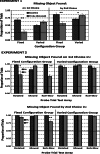Rats (Rattus norvegicus) flexibly retrieve objects' non-spatial and spatial information from their visuospatial working memory: effects of integrated and separate processing of these features in a missing-object recognition task
- PMID: 26311419
- PMCID: PMC4701772
- DOI: 10.1007/s10071-015-0915-8
Rats (Rattus norvegicus) flexibly retrieve objects' non-spatial and spatial information from their visuospatial working memory: effects of integrated and separate processing of these features in a missing-object recognition task
Abstract
After being trained to find a previous missing object within an array of four different objects, rats received occasional probe trials with such test arrays rotated from that of their respective three-object study arrays. Only animals exposed to each object's non-spatial features consistently paired with both its spatial features (feeder's relative orientation and direction) in the first experiment or with only feeder's relative orientation in the second experiment (Fixed Configuration groups) were adversely affected by probe trial test array rotations. This effect, however, was less persistent for this group in the second experiment but re-emerged when objects' non-spatial features were later rendered uninformative. Animals that had both types of each object's features randomly paired over trials but not between a trial's study and test array (Varied Configuration groups) were not adversely affected on probe trials but improved their missing-object recognition in the first experiment. These findings suggest that the Fixed Configuration groups had integrated each object's non-spatial with both (in Experiment 1) or one (in Experiment 2) of its spatial features to construct a single representation that they could not easily compare to any object in a rotated probe test array. The Varied Configuration groups must maintain separate representations of each object's features to solve this task. This prevented them from exhibiting such adverse effects on rotated probe trial test arrays but enhanced the rats' missing-object recognition in the first experiment. We discussed how rats' flexible use (retrieval) of encoded information from their visuospatial working memory corresponds to that of humans' visuospatial memory in object change detection and complex object recognition tasks. We also discussed how foraging-specific factors may have influenced each group's performance in this task.
Keywords: Object recognition; Rat spatial cognition; Working memory.
Figures






Similar articles
-
Hierarchical use of cues in the missing object recognition task by rats (Rattus norvegicus).Behav Processes. 2013 Jul;97:41-52. doi: 10.1016/j.beproc.2013.04.007. Epub 2013 Apr 17. Behav Processes. 2013. PMID: 23602980
-
Changing within-trial array location and target object position enhances rats' (Rattus norvegicus) missing object recognition accuracy.Anim Cogn. 2012 Sep;15(5):771-82. doi: 10.1007/s10071-012-0501-2. Epub 2012 Apr 26. Anim Cogn. 2012. PMID: 22535490
-
Infants use temporal regularities to chunk objects in memory.Cognition. 2016 Jan;146:251-63. doi: 10.1016/j.cognition.2015.09.022. Epub 2015 Nov 9. Cognition. 2016. PMID: 26484498
-
Does visual working memory represent the predicted locations of future target objects? An event-related brain potential study.Brain Res. 2015 Nov 11;1626:258-66. doi: 10.1016/j.brainres.2014.10.011. Epub 2014 Oct 17. Brain Res. 2015. PMID: 25445999 Review.
-
Interpreting the orientation of objects: A cross-disciplinary review.Psychon Bull Rev. 2024 Aug;31(4):1503-1515. doi: 10.3758/s13423-024-02458-8. Epub 2024 Feb 1. Psychon Bull Rev. 2024. PMID: 38302790 Free PMC article. Review.
Cited by
-
Learned Use of Picture Cues by Bumblebees (Bombus impatiens) in a Delayed Matching Task.Behav Sci (Basel). 2016 Oct 14;6(4):22. doi: 10.3390/bs6040022. Behav Sci (Basel). 2016. PMID: 27754410 Free PMC article.
-
Assessing object-recognition memory in rats: Pitfalls of the existent tasks and the advantages of a new test.Learn Behav. 2019 Jun;47(2):141-155. doi: 10.3758/s13420-018-0347-9. Learn Behav. 2019. PMID: 30132280
References
-
- Benhamou S. Place navigation in mammals: a configuration-based model. Anim Cogn. 1998;1:55–63. doi: 10.1007/s100710050007. - DOI
Publication types
MeSH terms
LinkOut - more resources
Full Text Sources
Other Literature Sources

